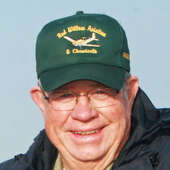- Trail: Celebrating New Yearís Eve, number 2025 (1/7/25)
- Trail: Year in review: pool, chamber and Jimmy Carter (12/31/24)
- Trail: 87 Christmases Passed (12/24/24)
- Dining in December at Camp Comeca (12/17/24)
- Trail: Getting in the seasonís spirit (12/10/24)
- Trail: Yuletide joy and airport blues (12/3/24)
- A Thanksgiving reflection on history and freedom (11/26/24)
Editorial
Harbinger of spring
Tuesday, April 2, 2013
It is a sure sign of spring and wonderfully welcome. Grannie and I drove to Omaha for Easter with our daughter and family. Along Interstate 80, over the many miles that it parallels the Platte River, sandhill cranes by the hundreds (thousands?) were spotted feeding in the fields.
It is a spring ritual with Grus canadensis stopping to replenish their body fat. They migrate from winter grounds in Texas and Mexico back to northern Canada to nest and rear their yearly crop of young. We Nebraskans tend to be a bit blasť about the phenomena but interested tourists from the world around come to gaze and enjoy.
The sandhill crane migration has been occurring from well before the advent of recorded history, ever since the Platte became flat and shallow enough for the long legged cranes to spend each night standing in the slow flowing current in safety. They also like the multitude of naked islands formed where the Platte meanders. Their days are spent in open fields near the Platte eating grass seeds, insects and gastropods. In modern times the flood plains along the Platte are intensely farmed primarily to corn. Mechanized corn culture leaves considerable grain to be gleaned so the cranes are able to stuff themselves gaining needed weight to lay eggs and hatch their young. It would seem that good feed has been a boon to the crane population as their numbers are hugely greater than before the area was farmed, much to the chagrin of green feeling ecologists. Hard to face facts when one is green and knows that our farm culture is bad, bad, bad! Gee cranes of ancient heritage may even be eating modern GMO grain which ecologists know is doubly bad. Maybe the greens should require that the fields where roundup ready crops and those that are corn borer and rootworm resistant are grown be posted to inform the cranes not to eat here.
Internet-savvy readers click on: http://www.ustream.tv/channel/rowe-sanctuary-s-crane-cam . As the address implies there is a live action camera "crane cam" set up to monitor the birds.
Both sight and sound plays continuously while the cranes are present though the screen is black at night. Following a tip from my brother Tom, I too find the crane "talk" to be a delightfully comforting "white noise" to play in the background. Beware though the primal sounds of nature are rudely interrupted at intervals by pesky commercials.
This year driving past, we observed the majority of the newly arrived cranes with heads down and actively feeding. I noted that a vast majority of the birds were feeding in the corn fields but a portion of the flocks were using their beaks to explore grassy fields and pastures picking in the recently rained upon soil.
In past years exploring country roads off the interstate south and east of Lexington we have observed cranes resting and soaking up sun during mid-day. A few of those birds displayed their breeding plumage and did the stiff legged hop that is a courtship ritual. We found it fascinating.
The cranes don't seem to find the area along our Republican River attractive, although I have seen them feeding in corn fields south of McCook on rare occasion. Any person privileged to spend time in the open away from the hubbub and noise of modern civilization can enjoy the sight of skein (formations of geese are called skeins is it same for cranes?) after skein of the ancient birds migrating overhead. Cranes adopt the same close formation vee in flight as do geese to gain the advantage of aerodynamic boost from the bird in front of them. Cranes though are less disciplined in flight than geese who in my opinion are masters of the trade.
To date we have not signed up for any of the commercial ventures offered to observe the cranes close at hand. Those tours are guided by crane experts so the experience may well be worth the cost involved. Driving yourself, being respectful of the private properties where the cranes feed and spend the day can cost very little. In my opinion it is the best of all worlds. Nature at its finest.
That is the way I saw it.

